

| Donatello executed two works in Padua--the high altar for Sant'Antonio with bronze reliefs and this bronze equestrian statue, a commemorative monument for the recently deceased Venetian condottiere, Erasmo da Narni (nicknamed Gattamelata or "honeyed [or cunning] cat," a reference to his Mother's name, Melania Gattelli). This monument, set on a high marble base, is in front of Sant'Antonio, the main church of Padua in a space then used as a cemetery. The statue is no doubt based on the famous equestrian monument in Rome of Marcus Aurelius, then thought to be of the Christian emperor Constantine. This work became the prototype for honoring a military heroes (at some point perhaps Venetian restorers will have finished with Verrochio's monument to Colleoni so I can include pictures of this late work in the Renaissance). The work is a powerful statement of Renaissance respect for military commanders since usually only heads of state would have received such honor; the horse's hoof, for example is on an orb, the ancient symbol for control over the earth. And although Gattamelata had died in his seventies, Donatello idealizes the general at the height of his powers. | ||

|
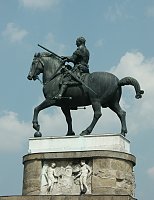
|
Donatello also designed the pedestal, which is about 25 1/2 feet tall, about twice as high as the bronze statue. At the top are two reliefs (see below) and below them false doors, which symbolize doors to the underworld. This gives the monument a sense of a tomb, although research has indicated that the monument never served as a burial place. That is, it is honorific, not funerary. |
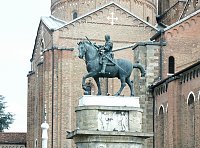
|
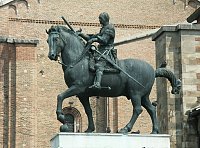
|
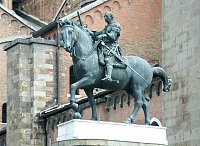
|
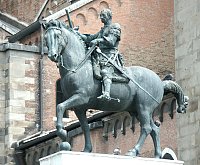
|
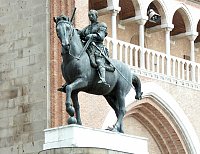
|
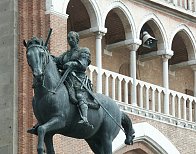
|

|

|

|
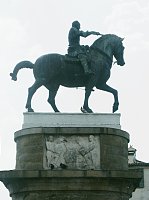
|

| |

|
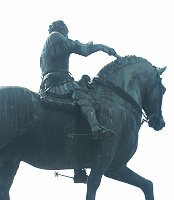
|

|

|
Relief on the baseOn the upper part of the base, there are two reliefs. On one side there are two putti pointing to a coat of arms of the deceased. On the other side there are two angels displaying battle armor. The original badly weathered reliefs were replaced with copies in the nineteenth century and are now located in the Santo Museum. Here the putti hold braids that form part of the coat of arms. (It's well nigh impossible to view the statue without ever-present pigeons, not all of which I could photoshop out!) |
|
 Click here to return to index of art historical sites.
Click here to return to index of art historical sites.
 Click here to return to index of artists and architects.
Click here to return to index of artists and architects.
 Click here to return to chronological index.
Click here to return to chronological index.
 Click here to see the home page of Bluffton University.
Click here to see the home page of Bluffton University.

